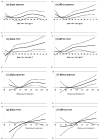Race- and sex-specific associations of obesity measures with ischemic stroke incidence in the Atherosclerosis Risk in Communities (ARIC) study
- PMID: 20093637
- PMCID: PMC2827672
- DOI: 10.1161/STROKEAHA.109.566299
Race- and sex-specific associations of obesity measures with ischemic stroke incidence in the Atherosclerosis Risk in Communities (ARIC) study
Abstract
Background and purpose: Studies have suggested differences in the association between obesity and ischemic stroke in black versus white populations. In this study, we explored ischemic stroke risk in relation to a variety of obesity measures by sex and race.
Methods: Using data from the Atherosclerosis Risk in Communities Study, we obtained information on body mass index, waist circumference, and waist-to-hip ratio from 13 549 black and white participants who were aged 45 to 65 years between 1987 and 1989. All were free of cardiovascular disease and cancer at baseline. Incident strokes over a median follow-up of 16.9 years were ascertained from hospital records.
Results: Although crude incidence rates of ischemic stroke varied more than 3-fold by race and sex, the relationship between higher measures of obesity and ischemic stroke risk was positive and linear across all groups. The crude incidence of ischemic stroke was 1.2 per 1000 person-years for white women with the lowest body mass index, ranging up to 8.0 per 1000 person-years for black men with the highest body mass index. Hazard ratios for the highest versus lowest quintile of body mass index, waist circumference, and waist-to-hip ratio ranged from 1.43 to 3.19, indicating increased stroke risk associated with obesity, however it was measured, even after adjustment for potential confounders. Additional adjustment for factors that may mediate the relationship, such as diabetes and hypertension, significantly attenuated the associations, suggesting that these factors may explain much of the stroke risk associated with obesity.
Conclusions: Degree of obesity, defined by body mass index, waist circumference, or waist-to-hip ratio, was a significant risk factor for ischemic stroke regardless of sex or race.
Figures

References
-
- Lloyd-Jones D, Adams R, Carnethon M, De Simone G, Ferguson TB, Flegal K, Ford E, Furie K, Go A, Greenlund K, Haase N, Hailpern S, Ho M, Howard V, Kissela B, Kittner S, Lackland D, Lisabeth L, Marelli A, McDermott M, Meigs J, Mozaffarian D, Nichol G, O'Donnell C, Roger V, Rosamond W, Sacco R, Sorlie P, Stafford R, Steinberger J, Thom T, Wasserthiel-Smoller S, Wong N, Wylie-Rosett J, Hong Y. Heart disease and stroke statistics--2009 update: A report from the American Heart Association Statistics Committee and Stroke Statistics Subcommittee. Circulation. 2009;119:e21–181. - PubMed
-
- Folsom AR, Prineas RJ, Kaye SA, Munger RG. Incidence of hypertension and stroke in relation to body fat distribution and other risk factors in older women. Stroke. 1990;21:701–706. - PubMed
-
- Folsom AR, Rasmussen ML, Chambless LE, Howard G, Cooper LS, Schmidt MI, Heiss G. Prospective associations of fasting insulin, body fat distribution, and diabetes with risk of ischemic stroke. The Atherosclerosis Risk in Communities (ARIC) Study Investigators. Diabetes Care. 1999;22:1077–1083. - PubMed
-
- Kurth T, Gaziano JM, Berger K, Kase CS, Rexrode KM, Cook NR, Buring JE, Manson JE. Body mass index and the risk of stroke in men. Arch Intern Med. 2002;162:2557–2562. - PubMed
Publication types
MeSH terms
Grants and funding
- N01 HC055016/HL/NHLBI NIH HHS/United States
- P30 ES010126/ES/NIEHS NIH HHS/United States
- N01 HC055019/HL/NHLBI NIH HHS/United States
- N01-HC-55016/HC/NHLBI NIH HHS/United States
- N01 HC055015/HL/NHLBI NIH HHS/United States
- N01-HC-55021/HC/NHLBI NIH HHS/United States
- N01-HC-55019/HC/NHLBI NIH HHS/United States
- N01-HC-55015/HC/NHLBI NIH HHS/United States
- N01-HC-55020/HC/NHLBI NIH HHS/United States
- N01 HC055018/HL/NHLBI NIH HHS/United States
- N01 HC055022/HL/NHLBI NIH HHS/United States
- N01-HC-55018/HC/NHLBI NIH HHS/United States
- N01-HC-55022/HC/NHLBI NIH HHS/United States
- N01 HC055021/HL/NHLBI NIH HHS/United States
- N01 HC055020/HL/NHLBI NIH HHS/United States
- N01 HC055019/HC/NHLBI NIH HHS/United States
LinkOut - more resources
Full Text Sources
Other Literature Sources
Medical

